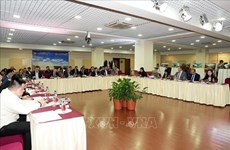Central Highland Dak Nong toasts decade of development
After 10 years of establishment, with a spirit of self-reliance,
dynamism and creativity, Dak Nong province has achieved many important
accomplishments, strongly affirmed its new position in the Central
Highlands and contributed to the national development. The Vietnam
Business Forum reports.
After 10 years of establishment, with a spirit of self-reliance,
dynamism and creativity, Dak Nong province has achieved many important
accomplishments, strongly affirmed its new position in the Central
Highlands and contributed to the national development. The Vietnam
Business Forum reports.
The most notable achievement is the province’s high economic growth. The average annual GDP growth was 7.3 percent in the 2000-2003 period and 13.8 percent in the 2004-2013 phase. Gross domestic product (GDP) valued at more than 32 trillion VND (over 1.5 billion USD) in 2012, 21.6 times higher than in 2003. Income per capita continuously increased year after year from 3.83 million VND in 2003 to 29.87 million VND in 2013, an increase of 7.8 times.
The economic structure has shifted towards a positive pattern, with a declining proportion of agricultural and aquatic value and an increasing proportion of service, industry and construction.
The proportion of agriculture in the province’s GDP is 71.8 percent in 2003, the percentage of industry and construction was 9.2 percent, and the proportion of services was 19 percent in 2003 but the respective proportions were 55.32 percent, 22,04 percent and 22.64 percent in 2013. Total budgetary revenue increased to estimated 1.5 trillion VND in 2013, an increase of 5.3 times over 2003.
Agricultural, forestry and aquatic production continuously expands and holds an underlying role in socioeconomic development in the province. Agricultural production has been restructured towards a positive pattern, with a greater emphasis placed on cash crops and livestock. Agricultural production valued more than 18.2 trillion VND in 2012, more than 9.3 times over 2003. Grain output was 366,430 tonnes in 2012, an increase of 2.8 times against 2003.
Industrial production scale expanded in most economic sectors. With a high growth, industrial output value reached 3.9 trillion VND in 2012, an increase of more than 10 times over 2003. To date, the province has built two large-scale industrial parks and five small-scale industrial complexes which are housing 80 investment projects with a total registered capital of 2.662 trillion VND, including 25 operational projects, 11 projects under construction, and 44 projects finalising investment procedures. Hydropower potential is tapped properly. The province currently has 16 hydropower plants in operation with a total capacity of 1,403MW. Mining industry has made great leaps forward. Nhan Co Alumina Plant has been constructed and expected to go into operation in late 2014. Nhan Co aluminium electrolysis plant, antimony production plant, and wolfram production plant in Dak Drong commune, Cu Jut district are being prepared for construction.
Trade and service always kept the annual growth of as high as 15 percent in the 2006 - 2013 phase. Export value grossed only 3 million USD in 2003 but it soared to 540 million USD in 2013.
Administrative reform is implemented synchronously. The application of quality management standards has initially enhanced the capacity of public administration. Administrative procedures have been reviewed and revised for the application of one-stop source mechanism at administrative offices. The deployment of solutions to raise the provincial competitiveness index (PCI) is always guided drastically by the Party and the Government. As a result, PCI has continually improved, with the reach to the good group in 2012. Dak Nong province was at the near-bottom position in the PCI ranking in 2007 but it took the 48th position out of the 63 provinces and cities nationwide.
Apart from economic development front, the province also attaches much importance to social and cultural development. The quality of education, training and health care is enhanced. Together with implementing target poverty reduction programmes, the province has spent considerable investment resources on production development and socioeconomic infrastructure development in far-lying ethnic minority-populated areas. In addition, Dak Nong has trained 35,825 rural workers and created jobs for 127,946 people since 2004. To date, the province’s poverty rate is 17.55 percent and near-poor households accounted for 5.7 percent.
The 10-year achievements are not only a pride but also a motivation for the Party, the authorities and the people of Dak Nong province to make more effort for better future development. The road ahead is forecast to be rough and challenging but the province is firmly confident it could shoulder all tasks and missions set by the 10th provincial Party Congress: Bringing Dak Nong out of the list of poor provinces by 2015 and becoming an average-level province by 2020, to create a firm foundation for comprehensive and sustainable development in the process of industrialisation and modernisation.-VNA
The most notable achievement is the province’s high economic growth. The average annual GDP growth was 7.3 percent in the 2000-2003 period and 13.8 percent in the 2004-2013 phase. Gross domestic product (GDP) valued at more than 32 trillion VND (over 1.5 billion USD) in 2012, 21.6 times higher than in 2003. Income per capita continuously increased year after year from 3.83 million VND in 2003 to 29.87 million VND in 2013, an increase of 7.8 times.
The economic structure has shifted towards a positive pattern, with a declining proportion of agricultural and aquatic value and an increasing proportion of service, industry and construction.
The proportion of agriculture in the province’s GDP is 71.8 percent in 2003, the percentage of industry and construction was 9.2 percent, and the proportion of services was 19 percent in 2003 but the respective proportions were 55.32 percent, 22,04 percent and 22.64 percent in 2013. Total budgetary revenue increased to estimated 1.5 trillion VND in 2013, an increase of 5.3 times over 2003.
Agricultural, forestry and aquatic production continuously expands and holds an underlying role in socioeconomic development in the province. Agricultural production has been restructured towards a positive pattern, with a greater emphasis placed on cash crops and livestock. Agricultural production valued more than 18.2 trillion VND in 2012, more than 9.3 times over 2003. Grain output was 366,430 tonnes in 2012, an increase of 2.8 times against 2003.
Industrial production scale expanded in most economic sectors. With a high growth, industrial output value reached 3.9 trillion VND in 2012, an increase of more than 10 times over 2003. To date, the province has built two large-scale industrial parks and five small-scale industrial complexes which are housing 80 investment projects with a total registered capital of 2.662 trillion VND, including 25 operational projects, 11 projects under construction, and 44 projects finalising investment procedures. Hydropower potential is tapped properly. The province currently has 16 hydropower plants in operation with a total capacity of 1,403MW. Mining industry has made great leaps forward. Nhan Co Alumina Plant has been constructed and expected to go into operation in late 2014. Nhan Co aluminium electrolysis plant, antimony production plant, and wolfram production plant in Dak Drong commune, Cu Jut district are being prepared for construction.
Trade and service always kept the annual growth of as high as 15 percent in the 2006 - 2013 phase. Export value grossed only 3 million USD in 2003 but it soared to 540 million USD in 2013.
Administrative reform is implemented synchronously. The application of quality management standards has initially enhanced the capacity of public administration. Administrative procedures have been reviewed and revised for the application of one-stop source mechanism at administrative offices. The deployment of solutions to raise the provincial competitiveness index (PCI) is always guided drastically by the Party and the Government. As a result, PCI has continually improved, with the reach to the good group in 2012. Dak Nong province was at the near-bottom position in the PCI ranking in 2007 but it took the 48th position out of the 63 provinces and cities nationwide.
Apart from economic development front, the province also attaches much importance to social and cultural development. The quality of education, training and health care is enhanced. Together with implementing target poverty reduction programmes, the province has spent considerable investment resources on production development and socioeconomic infrastructure development in far-lying ethnic minority-populated areas. In addition, Dak Nong has trained 35,825 rural workers and created jobs for 127,946 people since 2004. To date, the province’s poverty rate is 17.55 percent and near-poor households accounted for 5.7 percent.
The 10-year achievements are not only a pride but also a motivation for the Party, the authorities and the people of Dak Nong province to make more effort for better future development. The road ahead is forecast to be rough and challenging but the province is firmly confident it could shoulder all tasks and missions set by the 10th provincial Party Congress: Bringing Dak Nong out of the list of poor provinces by 2015 and becoming an average-level province by 2020, to create a firm foundation for comprehensive and sustainable development in the process of industrialisation and modernisation.-VNA












